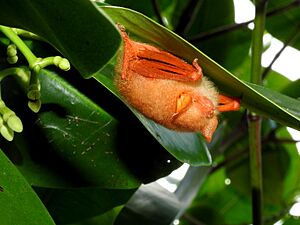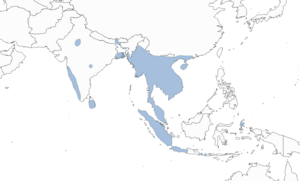Painted bat facts for kids
Quick facts for kids Painted bat |
|
|---|---|
 |
|
| Conservation status | |
| Scientific classification | |
| Genus: |
Kerivoula
|
| Species: |
picta
|
 |
|
| Species distribution (in southeast Asia) based on data from the IUCN. | |
The painted bat (scientific name: Kerivoula picta) is a super colorful type of bat! It's also called the painted wooly bat. People in Bangladesh sometimes call it the "butterfly bat" because of its bright colors. It belongs to a big family of bats called Vespertilionidae, also known as "vesper bats."
Contents
Where Do Painted Bats Live?
Painted bats live in many countries across Southeast Asia. You can find them in places like Bangladesh, India, China, Thailand, and Vietnam. They prefer dry woodlands. These bats are not very common, but they are spread out over a large area.
For a long time, people thought these bats were gone from Bangladesh. The last time someone saw one there was way back in 1888! In 2015, experts said they didn't have enough information about the bat in Bangladesh. But then, in June 2021, a painted bat was found again in Madhupur National Park. It was a big rediscovery after 133 years!
What Do Painted Bats Look Like?
The painted bat is very small and light. Its body and tail are about the same length, from 3 to 5.5 centimeters (about 1 to 2 inches). Their wingspan can be from 18 to 30 centimeters (about 7 to 12 inches). They weigh only about 5 grams, which is like two pennies!
These bats are bright orange or scarlet red. Their wings are black, but they have orange along their "fingers." Like other bats in their group, Kerivoula, they have long, wooly, and curly hair. They also have a small, delicate body and large, funnel-shaped ears. Their ears are bare and have a rounded tip. The part inside their ear, called the tragus, is long, thin, and see-through. Their snout is very hairy, but their nostrils are bare. Older male bats are usually brighter in color than females.
How Do Painted Bats Behave?
Painted bats are active at night or during twilight hours. They often roost, or rest, in unusual places. You might find small groups of them in the hanging nests of weaver finches or sunbirds. They also like to hide under banana tree leaves or the edges of huts.
These bats usually roost in pairs or small groups of only 2 to 6 bats. They seem to rest deeply during the day. If you disturb them, they move quite slowly. Their bright, patchy colors might help them hide. They can blend in with dried leaves and flowers, making them hard to spot!
Painted bats mostly eat small insects. They go out hunting for food for about 1 to 2 hours at a time.
Painted Bat Reproduction
Not much is known about how painted bats reproduce or how long they live. However, they form small family groups. These groups usually include a mother, a father, and one baby bat. They typically breed between June and August. Female bats usually give birth to just one baby at a time.
Scientists think painted bats catch insects while flying. They use a special membrane between their legs, like a net, to scoop up bugs in the air.
How Painted Bats Use Echolocation
Echolocation is how bats use sound to "see" their surroundings. Painted bats use echolocation in a way similar to other bats in their group. They make very high-pitched sounds that range from 156.9 kHz down to 41.5 kHz. These sounds are very quick and wide-ranging.
The sounds they make when flying are different from the sounds they make when resting. Bats that start their calls at higher frequencies are better at catching prey near obstacles. This is helpful for painted bats because their habitats often have a lot of leaves and branches.
Images for kids




